
BRADENTON (Manatee County)
EARLY SETTLEMENT ON THE MANATEE
RIVER
BRADENTON and the surrounding Manatee River area has a rich history starting
with large Indian settlements (see the MADIRA BICKEL INDIAN MOUNDS on
Terra Ceia) to the arrival in 1539 of Spanish
explorer Hernndo DeSoto
(see DESOTO NATIONAL MEMORIAL).
.
By the
1850's sugar plantations lined the River (see the GAMBLE
MANSION and BRADEN
CASTLE) (shown in 1933 postcard by
John Ludwig) and homesteaders like Josiah Gates started a town of Manatee. The Civil War
could not curtail the agricultural benefits of the region and the coming of the
railroad boomed the port town. In the 1920s Northerners found Manatee County's beaches and the Manatee River. When I taught at Manatee County, locals still went to Sarasota County for dining and entertainment, but slowly that has changed as Manatee County has attracted more and more upscale developments like Lakewood Ranch.
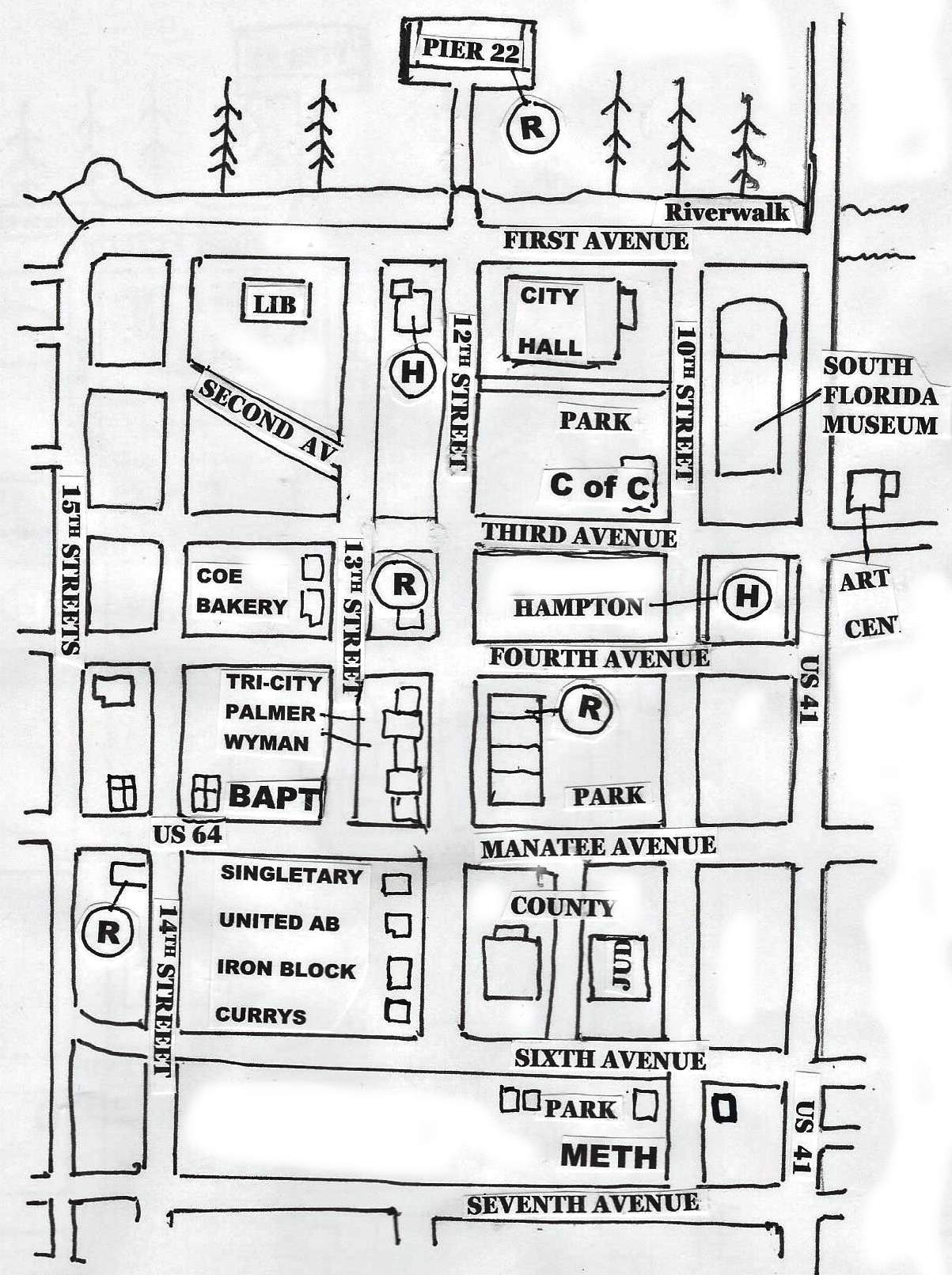 WHERE TO START: To best understand Bradenton's roots travel west from
I-75 on FL 64 (Manatee Avenue) or east from US41 or US301 on FL 64 to the:
WHERE TO START: To best understand Bradenton's roots travel west from
I-75 on FL 64 (Manatee Avenue) or east from US41 or US301 on FL 64 to the:
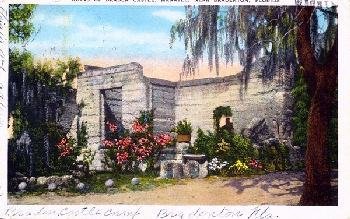
(A) MANATEE VILLAGE HISTORICAL PARK
(749-1765), at 604 15th Street
East off Manatee
Avenue. Open weekdays and Sunday afternoons
(EXCEPT in July and August), the Park is adjacent to the 1850 Manatee Cemetery
near the original settlement and contains the FIRST MANATEE COURTHOUSE
(1860), designed by Ezekiel Glazier, the oldest structure of its kind in
Florida. Across the mall is the OLD
METHODIST CHURCH
(1887), a fine restored church with a vaulted ceiling and "Star of
Creation" window. There is the 1912 SETTLERS COTTAGE,
home of Will Stephens' pioneer family, and the WIGGINS STORE.
CONTINUE
WEST ON MANATEE AVENUE past 15th
Street East, the first downtown district when the 1902 Railroad Bridge
opened here.
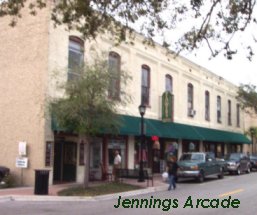 One half mile west on MANATEE AVENUE (FL64) you will
pass the ATLANTIC COASTLINE RAILROAD DEPOT (1920), built
on the site of the 1867 Fulmore House. You have
reached the later downtown district.
One half mile west on MANATEE AVENUE (FL64) you will
pass the ATLANTIC COASTLINE RAILROAD DEPOT (1920), built
on the site of the 1867 Fulmore House. You have
reached the later downtown district.
TURN
RIGHT ON TENTH STREET and drive toward the Manatee River.
On your right is the massive NEW MANATEE RIVER HOTEL (1925), 309 10th Street,now a major chain hotel,
built by the Van Sweringer Company of Cleveland for $850,000 in
the Land Boom. The pyramidal roofed corner towers are a city landmark. Across
the street by the telephone company Dizzy Dean operated a gas station in the
1930's.
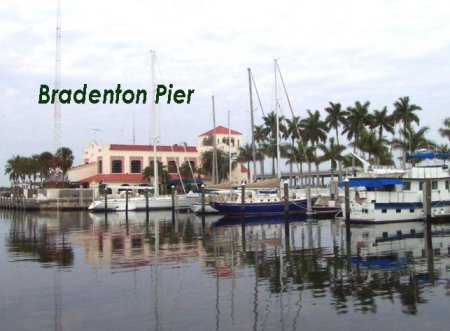
CONTINUE NORTH ON 10TH STREET by the: SOUTH FLORIDA MUSEUM AND
BISHOP'S PLANETARIUM (746-4131), 201 10th Street, an outstanding
historical museum with replicas of Timucuan villages,
DeSoto's Spanish home, and early Bradenton. A 200
seat planetarium with a Spitz star projector puts on special shows. Parking is
nearby. ADMISSION TO BOTH BUILDINGS. Across the way is
the CITY AUDITORIUM, 200
10th Street, a modern, glass structure.
TURN LEFT ON FIRST AVENUE. On your right is the busy yacht basin and the: CITY
PIER (1927), a two story Mediterranean Revival arcade with restaurant
on the site of Riggins Wharf where the Tampa steamboats stopped as early as
1879.
You may wish to PARK HERE to walk up
OLD MAIN STREET (12th Street West) or by FOLLOWING YOUR MAP visit the:
CARNEGIE LIBRARY (1918), 1405 4th Avenue West, designed by T. W. Hullinger, and housing the State of Florida's first
COUNTY HISTORICAL RECORDS LIBRARY.
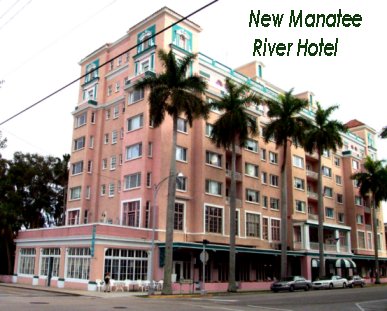 DRIVE SOUTH ON 12TH STREET WEST. CROSS THIRD AVENUE. On your right is the long HENRY L. COE
BUILDING (1897), 302-18
12th Street, three structures joined in 1914,
including the servant section of the lost St.
James Hotel.
DRIVE SOUTH ON 12TH STREET WEST. CROSS THIRD AVENUE. On your right is the long HENRY L. COE
BUILDING (1897), 302-18
12th Street, three structures joined in 1914,
including the servant section of the lost St.
James Hotel.
Across the street stood the 1887 Palmer-Gaar House destroyed for parking leaving only the 1925
Peninsular Telephone Building. At 320
12th Street is the BAKERY BUILDING (1910),
a two story vernacular once housing the Bradenton Board of Trade and Union Bus Station.
CROSS 4TH AVENUE onto the main block of Old Main Street. On your right at 400 12th Street is
the TRI-CITY TRUST BUILDING (1925), a Mediterranean Revival with
ceramic tile where the Sunnyland Restaurant was
housed.
Next door is the two story
PALMER BUILDING, once Paul Duckwall Grocery. The WYMAN & GREEN BUILDING (1923) shows the hounds
tooth course around the parapet reflecting its Boom Era style.
Across the street at 413 12th
Street is the wonderful F. M. JENNINGS
ARCADE (1926), with an original balustrade and iron grill work. At 421-427 12th Street
is the long ANDERSON-FINKHAM
BUILDING (1901),
actually two structures put together by Mrs. S. A. Reasoner
to form the Juplinor Hotel and its 1912 addition.
The tall three-story building across the way
is the LEON HARVEY BUILDING (1910), with the Cecil Hotel
the original upstairs tenant. At 436
12th Street is the BARER-CLIFTON BUILDING
(1909). The next door edifice with the chamfered entrance was the BRADENTON
PUBLISHING BUILDING (1910), later the eventful Western Union Office.
The last building on the right is the
important FULLER
BUILDING (1905), 450 12th Street, a
three story Renaissance Revival structure with native yellow rock and a
decorative tiled parapet. For years, it was the Manatee River National Bank.
The backside, known
as the CLIFTON ADDITION (1906) added offices.
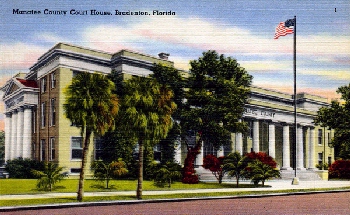 CROSS MANATEE AVENUE, the main street. On your left beyond the historic plaza is the
massive) MANATEE COUNTY COURTHOUSE (1913), a Neoclassical
building by Tampa's
McGucken & Hyer. It is
a "little larger" than the wooden one at the Manatee Village
Historical Park.
CROSS MANATEE AVENUE, the main street. On your left beyond the historic plaza is the
massive) MANATEE COUNTY COURTHOUSE (1913), a Neoclassical
building by Tampa's
McGucken & Hyer. It is
a "little larger" than the wooden one at the Manatee Village
Historical Park.
On your right is the two story SINGLETARY-CUMMINGS
BUILDING (1922), 520 12th Street, a
blond brick structure, once Lloyd's Drug Store. Next door is the delightful
Beaux-Arts style UNITED ABSTRACT BUILDING (1925), 526 12th Street.
Restored now at 530 12th Street
is the IRON BLOCK BUILDING (1896), its pressed metal facades
moved from Manatee Avenue
- a real gem for preservationists! The last structure on your right is WHITNEY
CURRY'S GARAGE (1913), the first in the city's history.
TURN LEFT ON SIXTH AVENUE. Immediately on your right is the WASHINGTON SQUARE
BUILDING (1925),
a rectangular seven unit office complex. Next door is the WALCAID ARCADE
(1924), a good Mediterranean Revival design, once home of the Bradenton
Electric Company.
At 603
11th Street is the imposing Neoclassical FIRST
METHODIST
CHURCH (1922)
featuring Ionic columns.
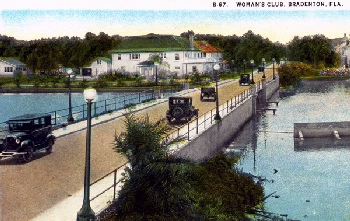 TURN LEFT ON 10TH
STREET and THEN LEFT ON MANATEE AVENUE to swing along the main esplanade. On the right,
opposite the Court House, is a block of old commercial buildings. The one with
the flat wooden awning and iron rods is the 1925 C. H. EWING
BUILDING.
TURN LEFT ON 10TH
STREET and THEN LEFT ON MANATEE AVENUE to swing along the main esplanade. On the right,
opposite the Court House, is a block of old commercial buildings. The one with
the flat wooden awning and iron rods is the 1925 C. H. EWING
BUILDING.
Next door is the R. M. BEALL BUILDING,
beginnings of a West Coast department store chain. Next comes the ALICE MARTIN BUILDING
(1914), first a drug store then W. E. Payne Jewelry. Next to the seven story N.C.N.B. Building is the long MURPHY-STEVENS BUILDING
(1916), where the local Woolworth opened in 1925.
TWO BLOCKS WEST ON MANATEE on the right is the: OLD FIRST BAPTIST CHURCH
(1912), 430 13th Street,
an Eclectic Romanesque Revival started by T. J. Sparkman. Next door is the new
church.
If you turn right in the next two blocks,
you'll return to the waterfront along one of the oldest residential areas. The
Riverview District west of downtown contains dozens of large houses of the
1920's. E. E. BISHOP HOUSE (1929), Riverview and 26th Street, is a
large estate of the father of the President of Standard Oil. Note BORDELEAU
at 3400 Riverview Boulevard.
3200
Riverview Boulevard (1899) is a huge Dutch Colonial estate on sixty acres.
PLACES FOR DINING AND STAYLING: Downtown Bradenton has numerous neat pubs like the McACBES'S IRISG PUB, (941-846-3126)302 Old Main Street. If you want a waterfront meal, PIER 22 RESTAURANT (941-748-8087), is a popular tourist spot. The big historic hotel is now HAMPTON INN and SUITES (941-746-9400). Near the pier at 102 12th Street is SPRINGHILL SUITES (941-226-2200). At 304 15th Street West is THE LONDONER B&B(941-741-4961) in a neat Victorian house.
OTHER
SITES AND BUILDINGS IN BRADENTON
MANATEE BURYING GROUND, 15th Street East
and just east of the Manatee
Historical Museum,
contains many Seminole War veterans, three members of the Florida Secessionist
Convention, and Brigadeer General John Riggin.
DR. JOSEPH ADDISON BRADEN CASTLE RUINS (1850), north of FL 64 in
Braden Castle Village, is a 900 acre sugar mill on the south bank of the
Manatee River until hit by Seminoles in 1856 and a forest fire in 1903.
BRADEN
CASTLE VILLAGE
(1924), set up by the Camping Tourists of America, contains 209 wonderful frame
bungalows, many of Craftsman style, built from 1924 to 1929, for winter
tourists. The community has a post office, meeting office, and docks. It is a
delightfully quiet trip into the 1920's.
WILLIAM SHAW TABBY HOUSE (1845), off 75th Street NW in the DeSoto National Memorial Park,
was destroyed during the Seminole attacks of the 1850's. It is located on the
nature trail at the site.
HISTORICAL RECORDS COLLECTION LIBRARY (1918), 1405 Fourth Avenue West, is in the Old
Carnegie Library mentioned earlier. This is an archive of documents and
records.
MANATEE COUNTY CENTRAL LIBRARY, EATON ROOM, 1301 Barcarrota Boulevard West,
contains a collection of books and materials on Manatee and Florida history.



 One half mile west on MANATEE AVENUE (FL64) you will
pass the ATLANTIC COASTLINE RAILROAD DEPOT (1920), built
on the site of the 1867 Fulmore House. You have
reached the later downtown district.
One half mile west on MANATEE AVENUE (FL64) you will
pass the ATLANTIC COASTLINE RAILROAD DEPOT (1920), built
on the site of the 1867 Fulmore House. You have
reached the later downtown district. 
 DRIVE SOUTH ON 12TH STREET WEST.
DRIVE SOUTH ON 12TH STREET WEST.  CROSS MANATEE AVENUE, the main street. On your left beyond the historic plaza is the
massive) MANATEE COUNTY COURTHOUSE (1913), a Neoclassical
building by
CROSS MANATEE AVENUE, the main street. On your left beyond the historic plaza is the
massive) MANATEE COUNTY COURTHOUSE (1913), a Neoclassical
building by  TURN LEFT ON
TURN LEFT ON